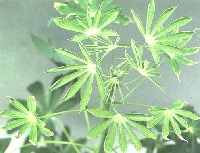
 |
|
 |
|||||||||||||||
Cu is a component of a large number of proteins and enzymes. It is also important for imparting disease resistance in plants. The main symptoms of Cu deficiency are chlorosis and deformity of the young leaves. Often the leaf tip becomes necrotic and the leaves are either cupped upwards or curled downwards. The number of lobes per leaf may be reduced to three or even one. Under severe deficiency, plants die back from stem apices and grow again from the base producing a bushy plant with one or more dead stems projecting from the top. Leaves in the middle of the plant are carried on abnormally long drooping petioles. Severe Cu deficiency can markedly reduce root development such plants susceptible to water stress. Cu deficiency is so far reported in peat soils and it is found that Cu deficiency could reduce yield from 15 to 4 t ha-1.
|
 |
|||||||||||||||